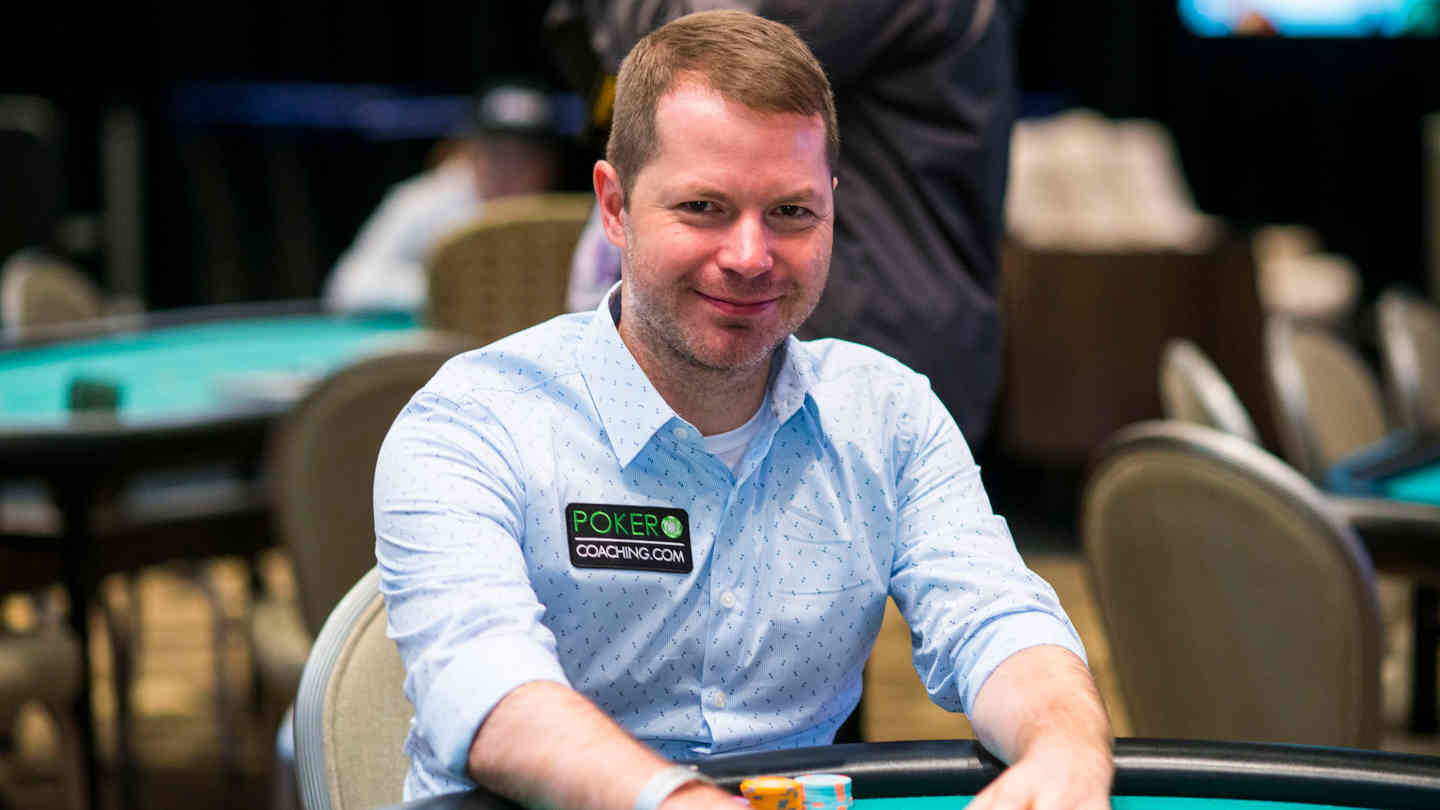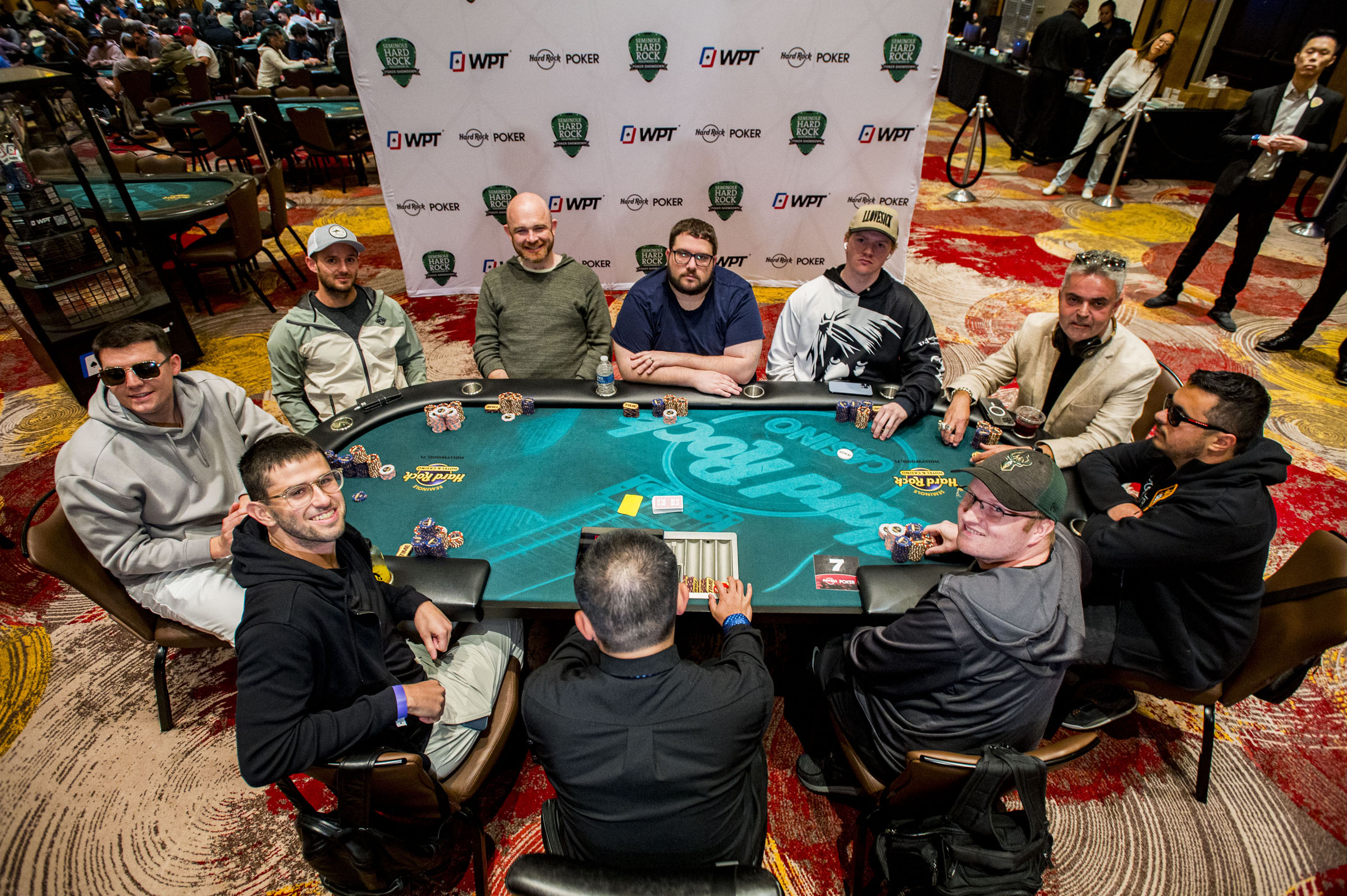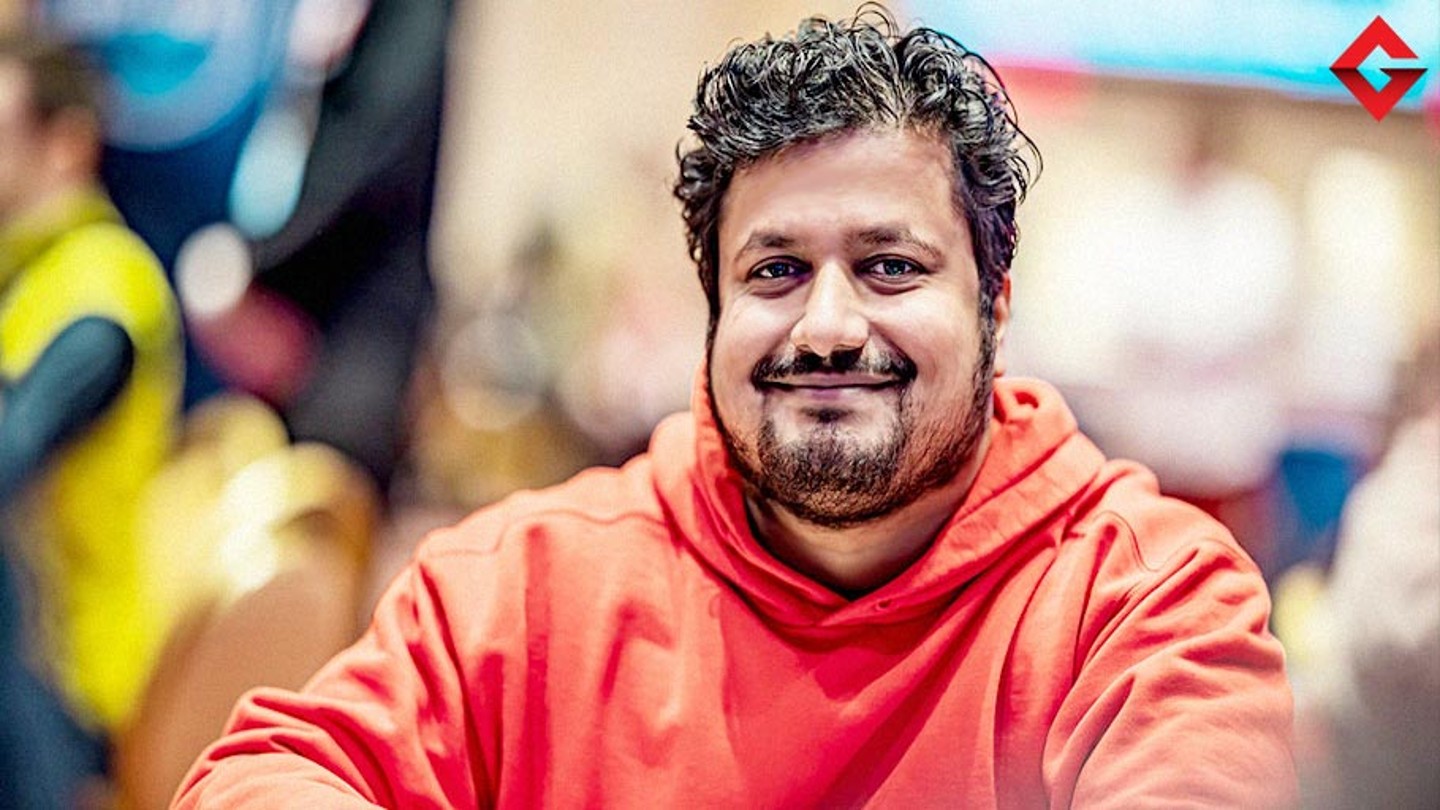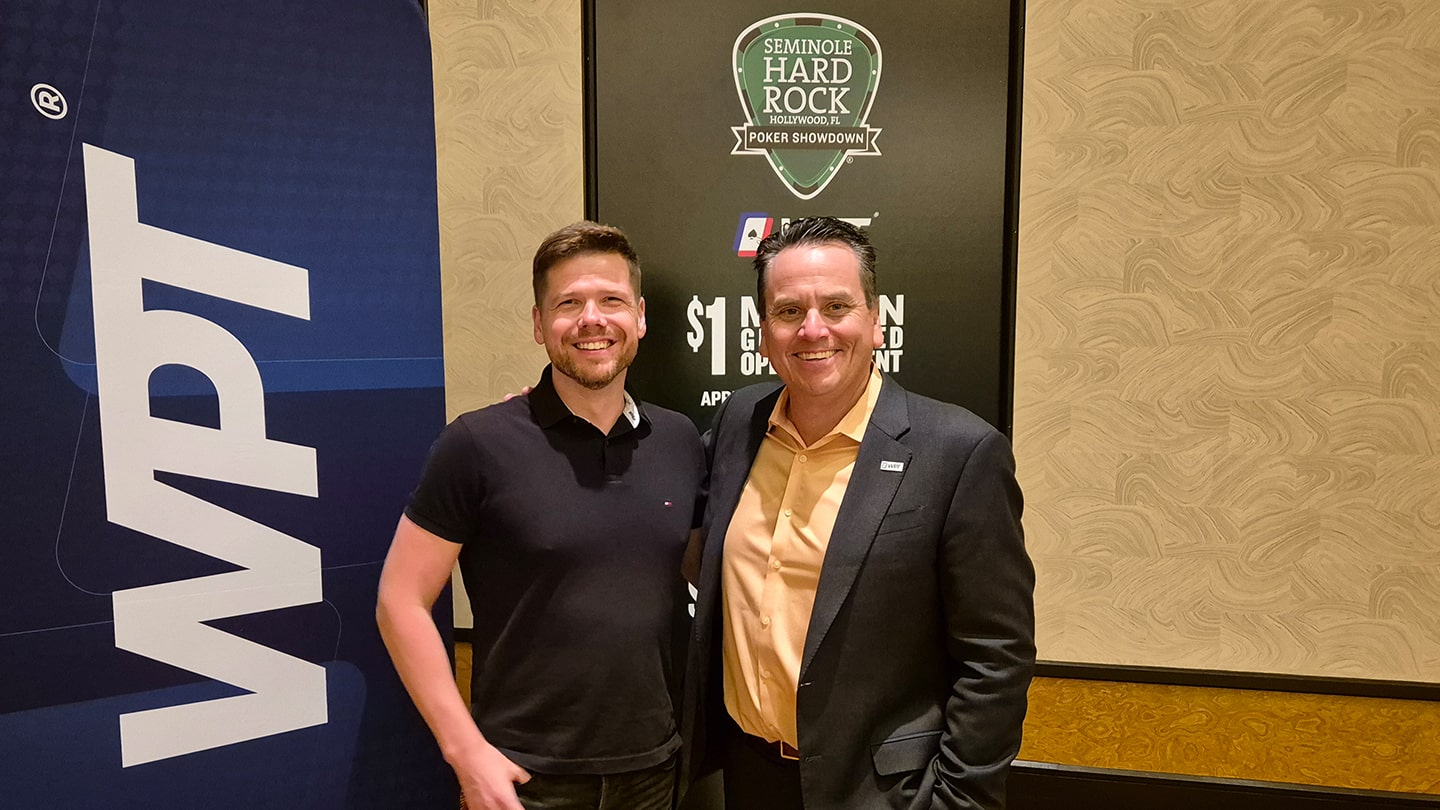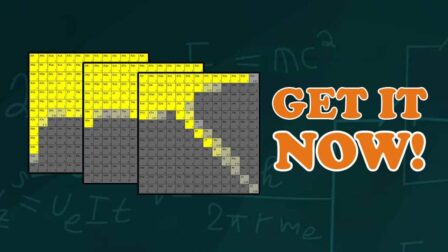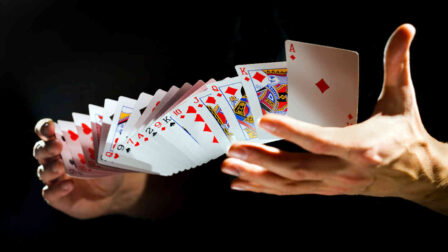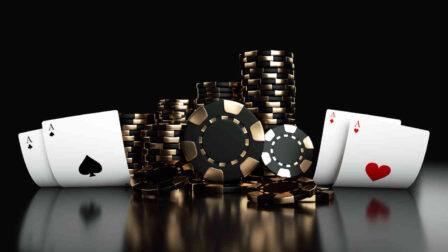Poker Ranges Explained – How to Play Your Hands Like a Pro
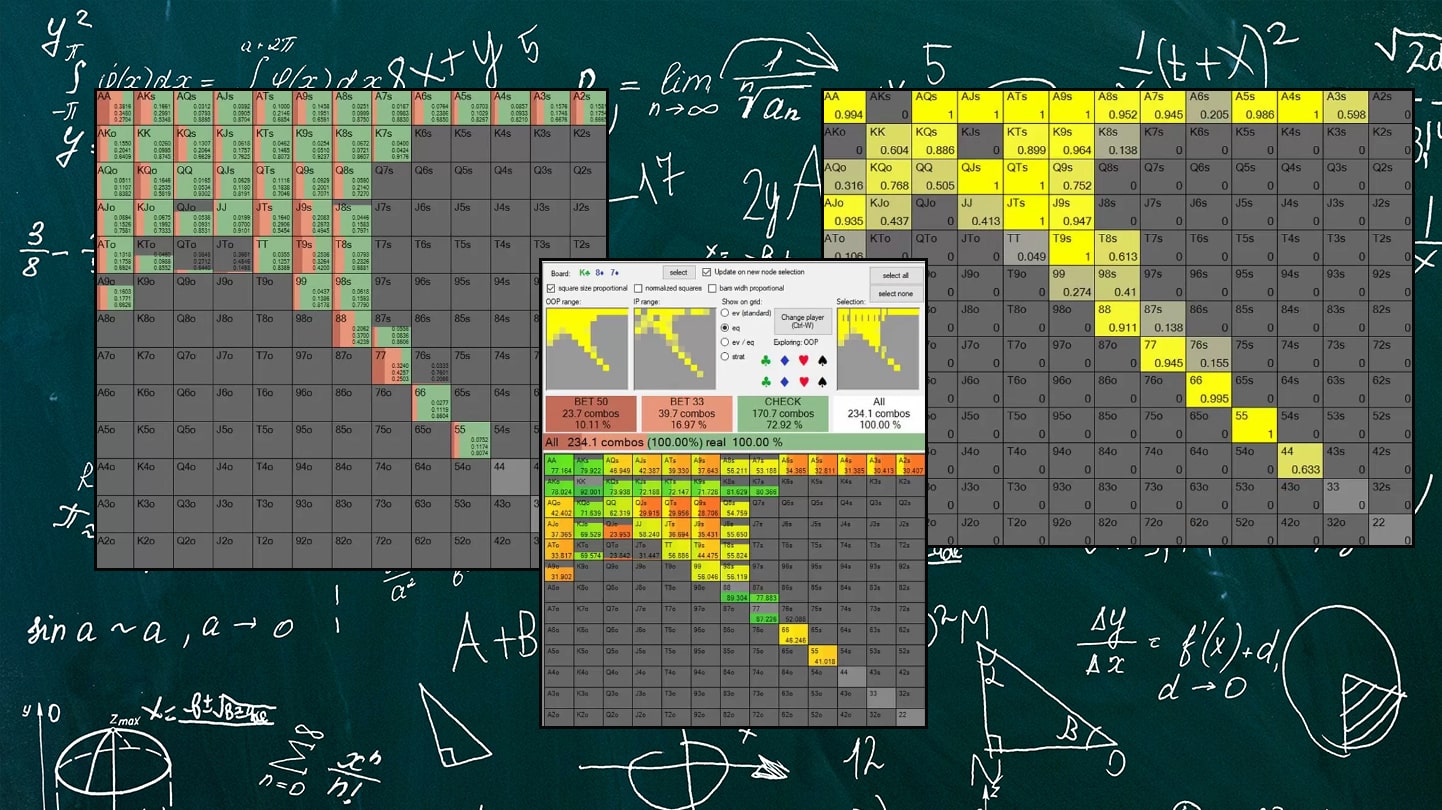
18 minutes
Last Updated: December 6, 2023
For many years, live and online poker players continually tried to guess their opponent’s exact cards while playing. As the game evolved and people started thinking harder about it, the concept of poker ranges was invented as a completely new way to think about the cards a particular player is holding in the hole.
Thinking about poker hands in terms of poker ranges is essential to becoming a serious poker player, as it is the only way to make educated decisions.
If you are new to the game or have only ever played recreationally, this article will help you think about poker in terms of poker ranges and teach you what a poker range is, how to construct ranges in poker, and how to put your opponents on a hand range instead of a particular hand.
Before I can teach you how to construct your hand ranges or think about your opponents’ ranges, let’s look a bit more deeply at what a poker range is and what it’s made up of.
What Is a Poker Hand Range?
In the simplest of terms, a poker range is a collection of poker hands that a particular player can have in the hole based on their actions.
When the cards are only just dealt, each player works with a 100% poker hand range comprising all the possible card combinations since they can have any cards at that point.
As the hand progresses, you can start to narrow down the hand ranges of each player at the table by looking at:
- Player actions
- Bet sizes
- Player tendencies
- Various tells
As soon as a player takes action, you can start to determine things about their hand range. If they make a raise or call, you can immediately start taking hands out of their range.
For example, a generally tight player raising from UTG+1 will never have a hand like 95 or K3, which means you can immediately take these and similar poker hands out of their range.
As the hand develops, you should always think back and remember which hands you have already eliminated from their range based on an earlier action.
Once a hand is eliminated from a hand range, it can never go back into it, as the poker range only continues to narrow down with each action if you are doing your assessment right.
Of course, determining another player’s poker hand range is always a bit of a guessing game, but the better you can guess, the more correctly you will be able to put your opponents on the correct range of holdings.
Poker Hand Ranges Breakdown – How To Put Your Opponent on a Range?
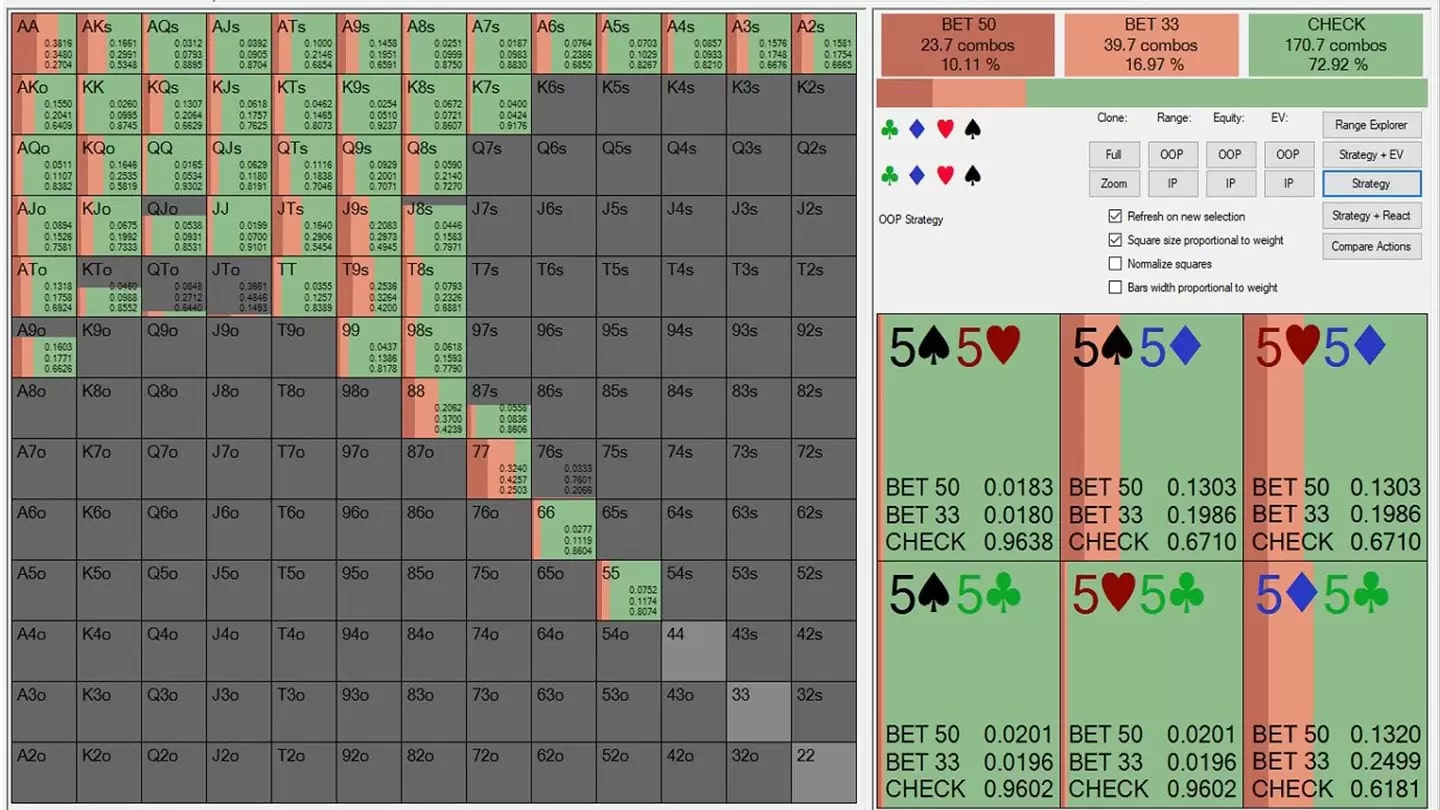
If you want to play poker like the pros do, you will need to start thinking in terms of ranges at all times, and you will need to stick to this strategy no matter what happens.
When thinking about your cards, you will want to always play a whole range of hands in a particular way to create a well-balanced range that can’t be easily exploited.
Your exact hand ranges will always depend on several factors, such as:
- Game Type
- Stack Size
- Your Position
- Previous Action
- Players to Act Behind
You can easily learn some basic hand ranges for your game type, whether it’s tournaments or cash games, by mimicking some successful players’ starting hand ranges. Actually, we even created a resource for that, so grab our free poker cheat sheet.
However, as the hand progresses and ranges narrow, you must learn to keep a balanced amount of bluffs and value bets in your range. Always remember that strong opponents are also thinking about your hand range instead of a particular holding.
Against weaker competition, you may want to build a poker range that is made up of more bluffs or more value bets, depending on their tendencies.
In either case, remember that how you construct your poker ranges impacts how other players look at you at the table and how they play against you. Let’s dive into this a bit deeper.
Defining Your Opponent’s Preflop Range
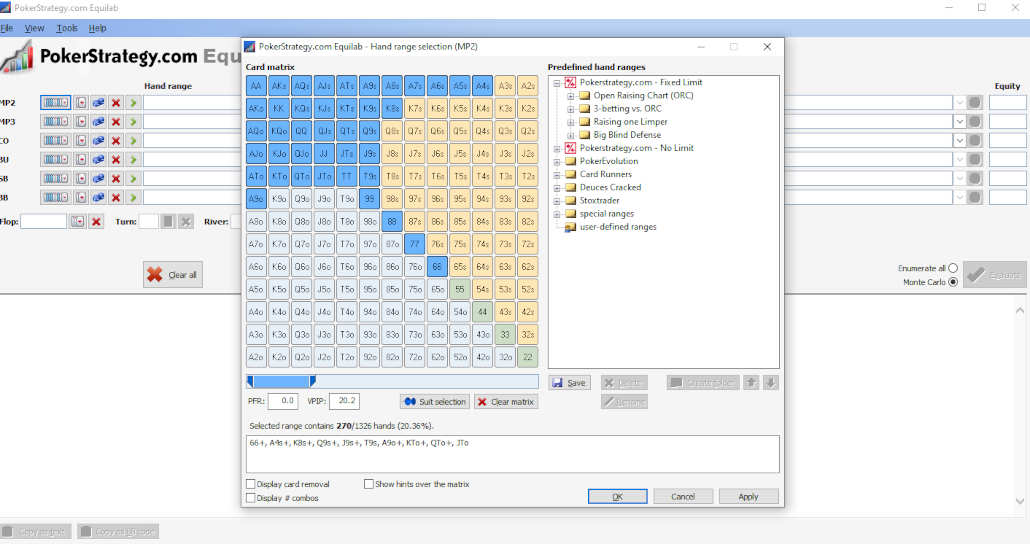
While you get to determine your own hand ranges and always know what they are, you won’t have as easy a job with your opponents’ ranges.
In fact, you will always have to do some guessing when trying to define another player's range, but with experience, you will be able to get better results in this.
Your baseline for determining an opponent's range will be their position and their general tendencies. Players who generally play looser will have a looser preflop opening, calling, and 3-betting ranges, as a rule.
You can start out by using a predefined solid preflop opening range, the same ones you would use to open from that position.
However, keep in mind that players won’t all play the same way that you do, which means you should think about adding hands into the ranges of players you deem looser and removing hands for those you deem to be tighter.
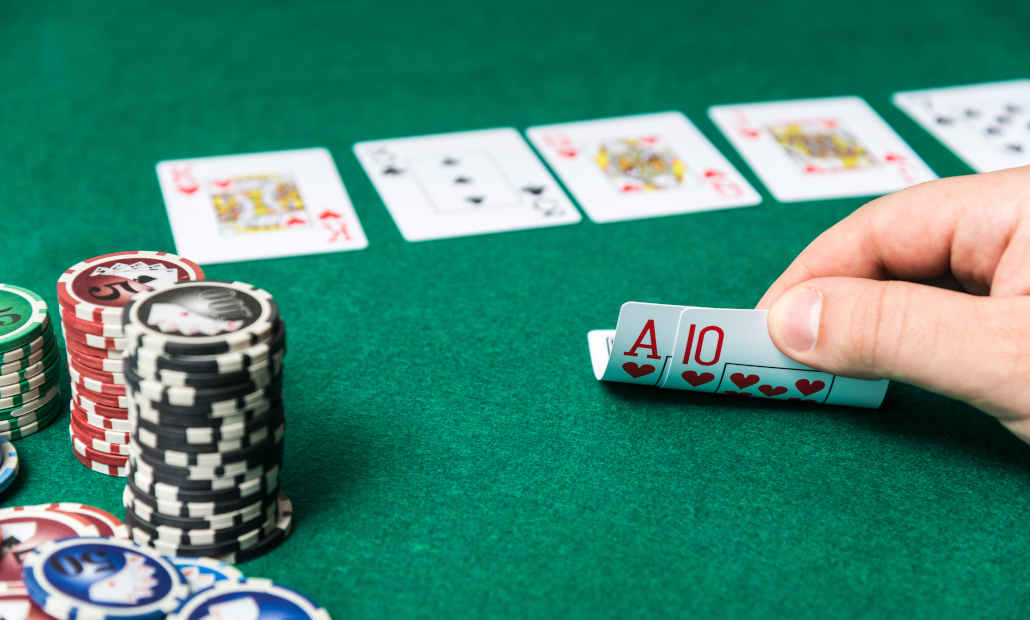
The preflop assumptions you make about a player’s range will matter a lot on later streets as they make bets and raises and further define their range.
If you make serious miscalculations before the flop, all the subsequent deductions you make will be partially wrong, as the initial range will be incorrect.
I recommend looking over your hand histories, trying to guess players' ranges in various spots, and seeing how often they turn up on the river with hands they were not supposed to have in the first place.
This kind of practice will help you with defining poker ranges in the future and understanding the game much better in general.
How Poker Ranges Change with Each Street
Once a flop is dealt and players start acting on their hands, serious changes happen in their ranges. Depending on the board texture and the actions they take, you can start removing hands from their range one by one.
Defining a range can be somewhat easier against solid, thinking players who will make reasonable decisions and not try to throw away their chips.
Against recreational players who sometimes make plays that don't make much sense, you should be a bit more careful about deciding whether they certainly do or don't have some hand in their range.
Yet, in all cases, you should be able to remove a good chunk of hands from a player’s range after they face some aggression and continue with the hand.
Poker Hand Range Breakdown Example
Let’s assume you raised the button and got called by the big blind in a ring game. This player is likely to still have a very wide range as they got a great price on a call and were closing the action.
However, once a flop is dealt K♠8♥4♥, they check, you c-bet 70% pot, and they call, and the situation changes quite drastically.
The player is out of position and decided to call your large continuation bet despite knowing they will have to act first on the turn.
There is some chance they are floating with a random hand like QT or A♠7♠, but this is not very likely. More likely is that they have a hand like Kx, 8x, 4x, a club draw, or one of the gutshot straight draws.
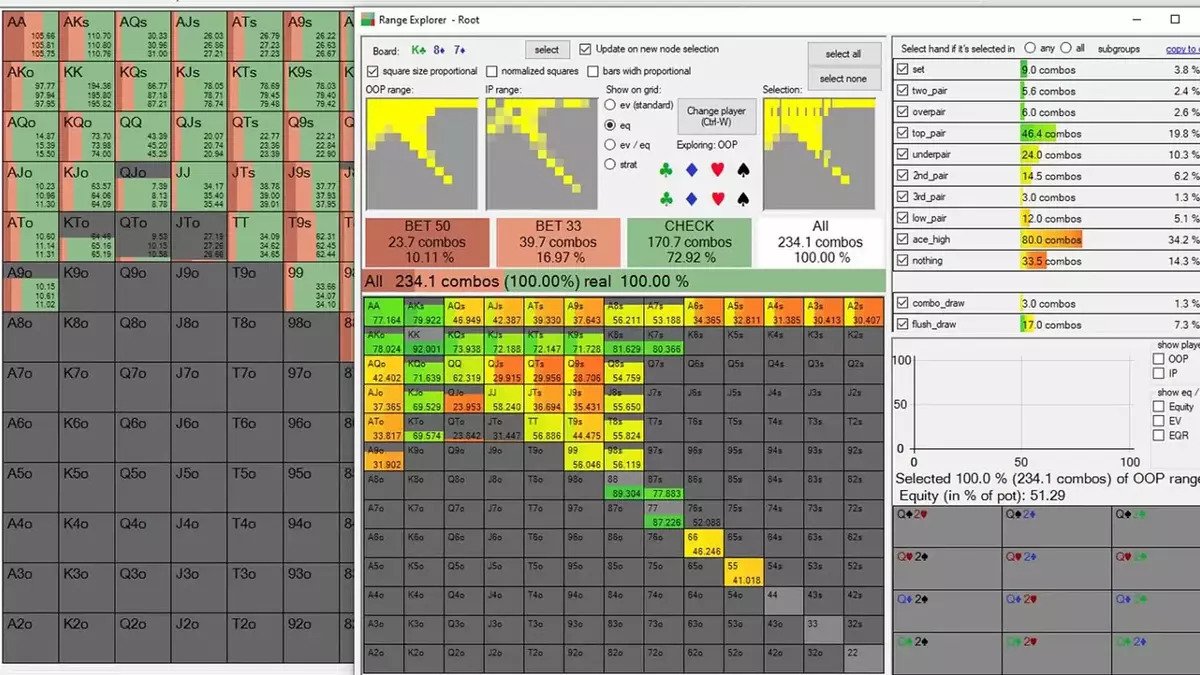
This is still a lot of hands that they may have, but not as many as preflop. Furthermore, many players may decide to raise their flush draws or combo draws on this board, making those less likely.
Considering the hands that are left in your opponent’s range, this is a board that presents a great opportunity for a double-barrel bluff on blank turns.
Should the turn bring an ace, queen, jack, ten, nine, three, deuce, or basically any other non-club, a second barrel will often win you the pot.
Your opponent will have a very hard time continuing past the turn with their gutshots, their pair of eights or fours, or pocket pairs like 77, 66, or 55.
You will, of course, run into trouble the few times they have a hand like K8, 88, or 44, but these hands are such a small percentage of their overall range.
Re-Evaluating Hand Ranges On The Turn
Let’s now assume the turn is a Q♦, you go for another 70% bet, and they call once again. At this point, hands like 8x and 4x should no longer be in their range, and neither should naked gutshots.
They are either trapping with a hand like KQ, K8, 88, or 44, or they have a combo draw or naked flush draw. Note that a naked flush draw should probably fold this turn, but many players will not fold a flush draw until the river, despite the betting action.
A hand like Kx is still possible, and some players may decide to still continue with some 8x.
While you still haven’t completely eliminated all hands but one from your opponent’s range, you now have a much better idea of what they have than you did before the flop.
Final Poker Hand Ranges on the River
Let’s assume the river brings 3s, making the board Ks 8h 4h Qd 3s. Your opponent checks on you, and you need to make an important decision about whether you want to bet or check back and go to the showdown.
Since you have a pretty good idea about his range, which hasn’t changed much since the turn, it makes your life easier.
At this point, value betting thin would not make much sense since your opponent is either trapping with a monster or will fold to your bet. As we mentioned, while he might have a random Kx hand, that is a very small part of his range, and he has way more sets and two-pair combinations.
Seeing someone turn over a hand like A♦9♦ after this kind of action will rarely happen, as this hand simply makes no sense considering the action. The same goes for many other hands, including gutshot straight draws like 65 or 76, etc. Therefore, you should not be bluffing much here as well.
While you still have to have some bluffs to be completely balanced, that should only be a couple of combos that do not block his weakest hands, and you should best only for value for the most part.
That is the power of putting others on a poker hand range. At the final betting street in the hand, you already have a pretty clear picture of what your opponents might have and can make proper adjustments.
As you continue getting more and more information throughout a hand, continue to remove hands from your opponent’s range until you are left with only a few, and often a fairly easy decision on the river.
Poker Range Chart – Starting Hands To Remember
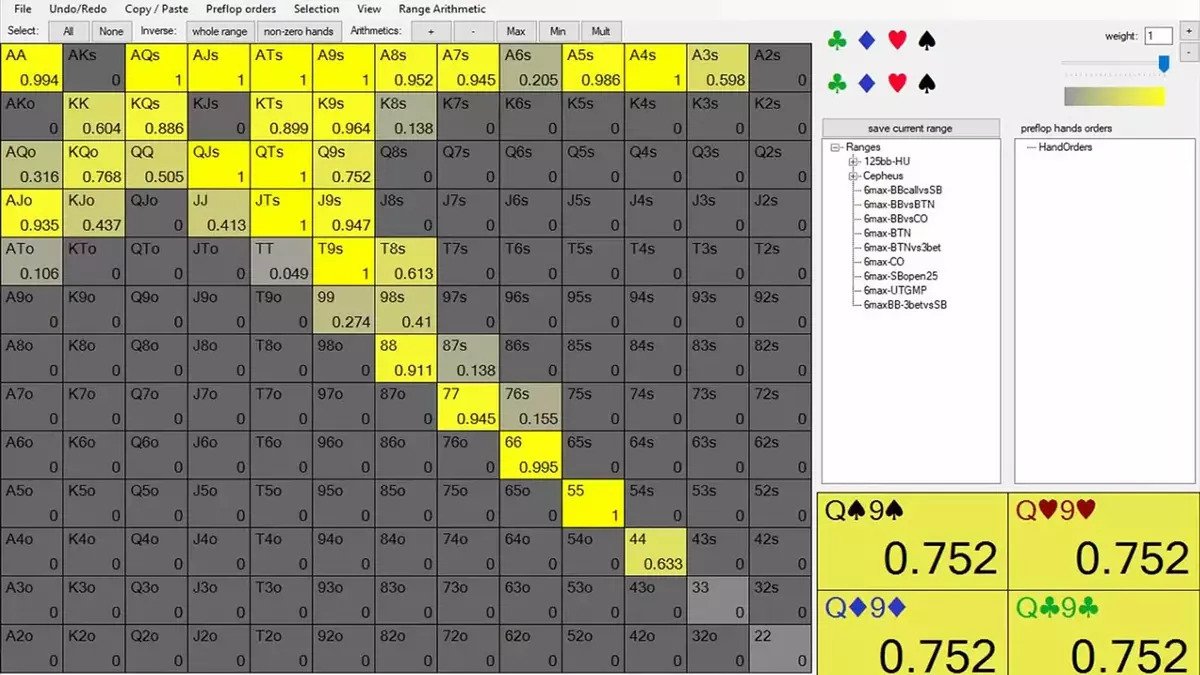
Now that you know how to write down poker ranges and why it’s important to construct solid hand ranges, let’s talk about some important opening ranges you should know.
Depending on your position at the table and other factors, such as effective stack size, you will want to open a particular percentage of your entire poker range.
The early position opens will always be relatively tight, while later positions should generally be looser. In both cases, you will also want to balance out your strong hands by adding some bluffs into your opening range.
Here are the five basic ranges of poker hands that you should know by heart:
- Top 2.5% Hands: QQ+, AK+
- Top 5% Hands: TT+, AQ+
- Top 10% Hands: 44+ , AJ+, KQ, KJs+
- Top 20% Hands: 22+, AT+, 65s+
- Top 33% Hands: 22+, A7+, A2s+, T9+, K8s+, J8s+, 43s+
These simple definitions for starting hand ranges represent the best hands that you can fit into the particular percentage of poker hands.
However, if you are playing a top 10% range, you should always remember to add some bluffs, such as 87s or 65s, into your opening range to avoid being too predictable and only have high cards and pairs in your range.
Once again, if you are playing against opponents who are not very observant, you can actually probably get away with playing a very straightforward poker range and still get great results, as your opponents simply don’t understand which cards you can or can’t have on various boards.
Poker Hands Charts – Writing Down Poker Ranges
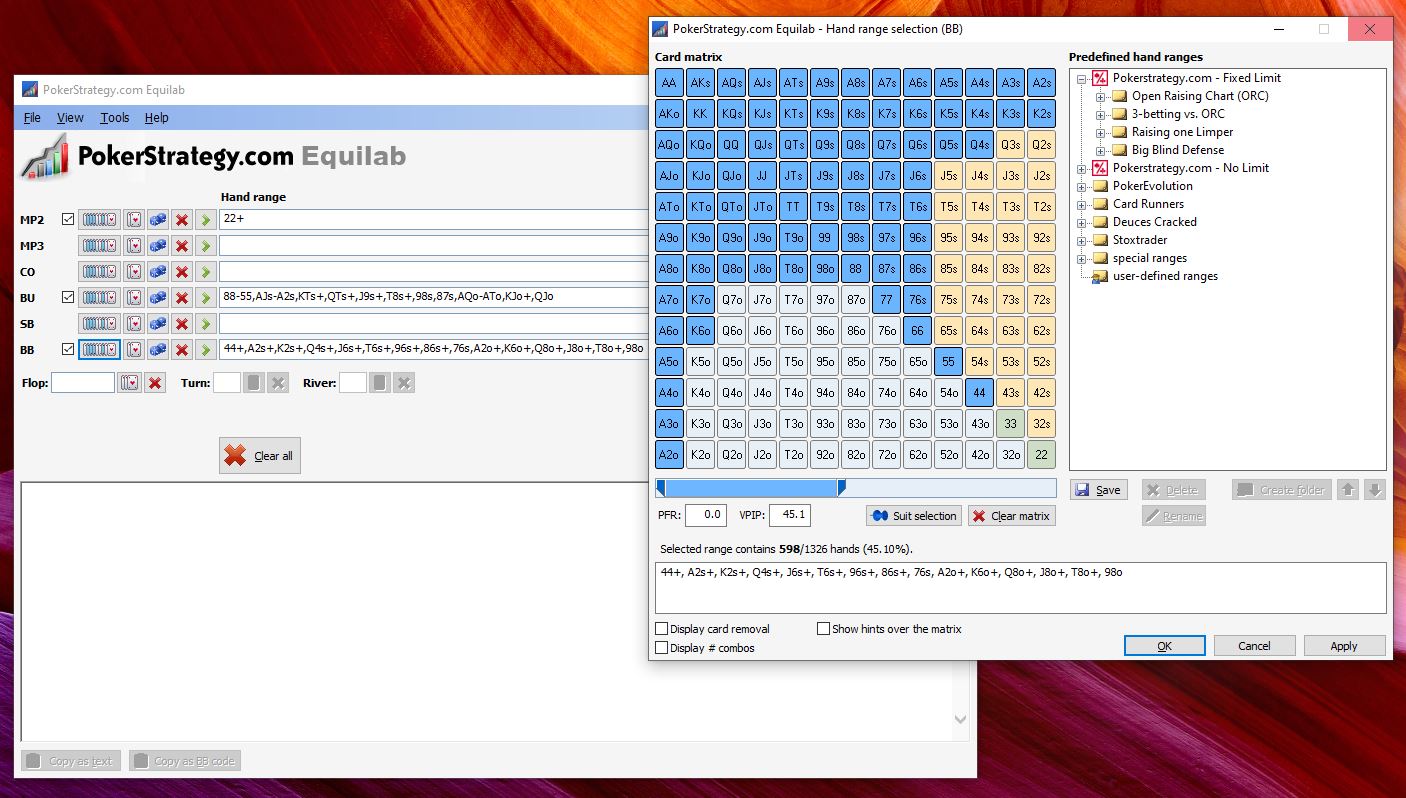
For the purposes of studying poker, you will need to use poker software such as Equilab or solvers, and all of these programs will include the hand grid and written hand ranges.
You will need to know how to read poker hand ranges so you can understand the different outputs and the suggestions your poker software is giving you.
Poker players have created a neat and simple way of writing down poker ranges that is easy to read and gives you an instant idea of which hands fall into a certain range.
When you see a hand range written down, here is what the different notations actually represent:
| Hand Notation | Hand Category |
| A2+ | All hands containing an ace |
| A2s+ | All hands containing an ace that are suited |
| 64s+ | All suited one gappers, starting with 64s and up to AKs |
| 22+ | All pocket pairs |
| 65s+ | All suited connectors starting with 65s |
| 66+ | All pocket pairs starting with 66 |
| Top x% | The best x% of hands (use Equilab to define) |
Using these notations, a strong preflop opening range might look like this: 66+, ATs+, AJ+, TJs+, KJs+, KQ.
A much wider opening range may look like this: 22+, A2s+, A8+, 76s+, 97s+, ATB (any two broadways), K9+, and J8+.
Balancing Hand Ranges in Poker
When it comes to creating poker ranges for both preflop and postflop play, a factor that many players don’t take into account is balance.
On the most basic level, starting poker players will always value bet their strong hands heavily and always check/fold their weak hands while check/calling their draws.
The problem with this kind of strategy is that it makes you extremely easy to play against, as your poker ranges become transparent to any thinking and observant player.
For this reason, good poker players try to balance out their ranges by introducing bluffs into their range in every situation when they are betting and checking some strong hands, check/raising some draws, etc.
The idea of balancing your poker range becomes extremely important when playing against strong players who are thinking about your range and trying to figure out what you are doing.
On the other hand, playing a very unbalanced range can become a big problem even against recreational players, as they too will notice if you are only ever betting for value or playing your cards too straightforwardly.
While playing a balanced range is important, many players who base their game on game theory optimal (GTO) solutions go too far in this regard when playing against weaker players.
So, let’s talk briefly about GTO poker and exploitative ranges and how you can apply both in different scenarios.
GTO and Exploitative Poker Ranges – Which Is Better?
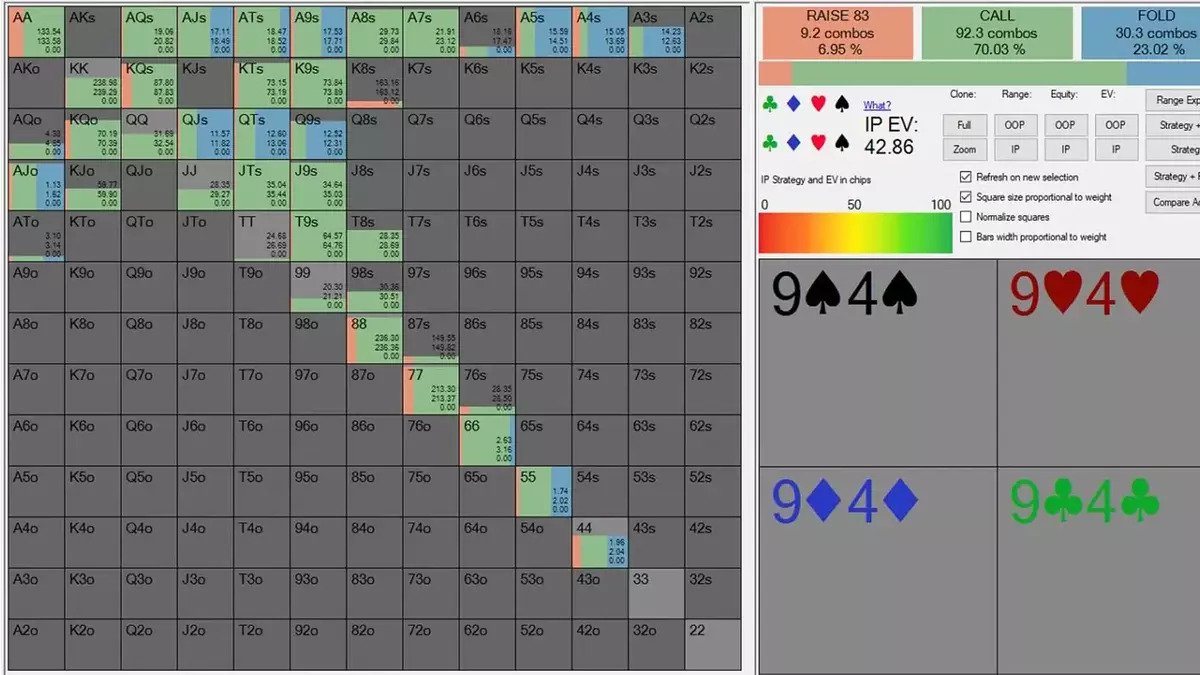
If you try learning poker using a poker solver such as PioSolver, you will learn a strategy that always plays a balanced strategy on every street.
This means your poker ranges will consist of a balanced number of bluffs and value bets in every situation, whether it is a big river shove or a simple preflop raise.
This kind of approach to poker is quite necessary when playing at the highest levels these days, as the opponents you are facing are playing a very balanced strategy themselves, making it very hard to exploit them.
However, against most players, playing a perfectly balanced poker strategy is probably a leak, as you are leaving a lot of money you could be making on the table.
For example, bluffing at a balanced frequency on turn and river against a massive calling station that calls all bets with any draw or any pair is a losing proposition. While you will still make money against them by playing a GTO strategy, you will also leave a lot of potential money you could have won on the table.
Likewise, only bluffing the hands that solver suggests against a nit who will fold everything but the nuts and will not chase any draws is just as big of a mistake.
You could be relentlessly pouncing on this player and making them fold hand after hand, knowing you are beaten when they call one of your bets.
At lower stakes, you will encounter many recreational players or bad regs who simply don’t play a balanced strategy themselves and whose play is very exploitable. If you aim to make the most money possible when playing poker, always try and figure out the level your opponents are playing at and respond in kind.
How to Exploit Other Players’ Ranges

I have already explained that playing balanced or GTO poker ranges in most games is not the optimal way to play poker, as most players are very exploitable. The trick to being able to exploit a player’s range is to always try and figure out what ranges your particular opponents play in different scenarios and go from there.
For instance, a solver will always assume that other players play according to the GTO strategy, which means they will fold a hand like a bottom pair or a gutshot straight draw to a big turn bet or will always raise with the strongest of draws.
However, the reality is that most players don’t play anywhere near the GTO strategy, and their plays are based completely on their own understanding of poker.
If you can predict which opponents play too tight preflop, which opponent folds too many draws, and who never folds four to the flush no matter what, you can exploit those players’ ranges quite heavily.
Of course, making exploitative plays against such players will also make you very exploitable, so make sure you only try to exploit in heads-up pots or when playing against multiple weaker opponents who are not very perceptive.
Generally speaking, you will want to find players who fold too much and call too much.
Exploit their poker ranges by betting a lot against those who overfold and betting only for value against those who overcall.
The truth is that most players in the world, regardless of game type or stakes, play a very exploitable poker strategy and construct their poker ranges in ways you can easily crush if you only spend enough time observing their actions.
Build Your Game Around the Concept of Poker Ranges
Poker has evolved quite a bit over the years, and the old way of thinking about it has become obsolete.
Gone are the days when trying to guess the exact hand your opponent has was considered a reasonable strategy, and thinking in terms of poker ranges is necessary to be considered a top-level player.
If you are looking to kick start your poker career today, you should start training your mind to always think about poker in terms of hand ranges and always be perceptive about both your poker range and those of your opponents.
I highly recommend starting by learning the most basic opening ranges from different positions and moving on to more complex hand ranges as you go on.
With some time and practice, you can effectively read your opponents’ poker hand range, exploit their tendencies and mistakes in building their ranges, and adjust your play for optimal results.
One thing that is crucial will be to stop playing your hand and start playing your entire range, street by street, always making sure to keep your opponents on their toes and guessing instead of making decisions easy for them.








